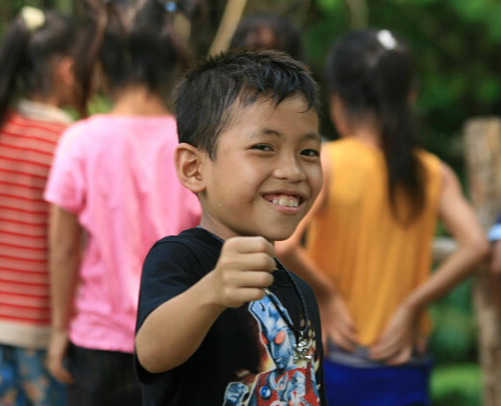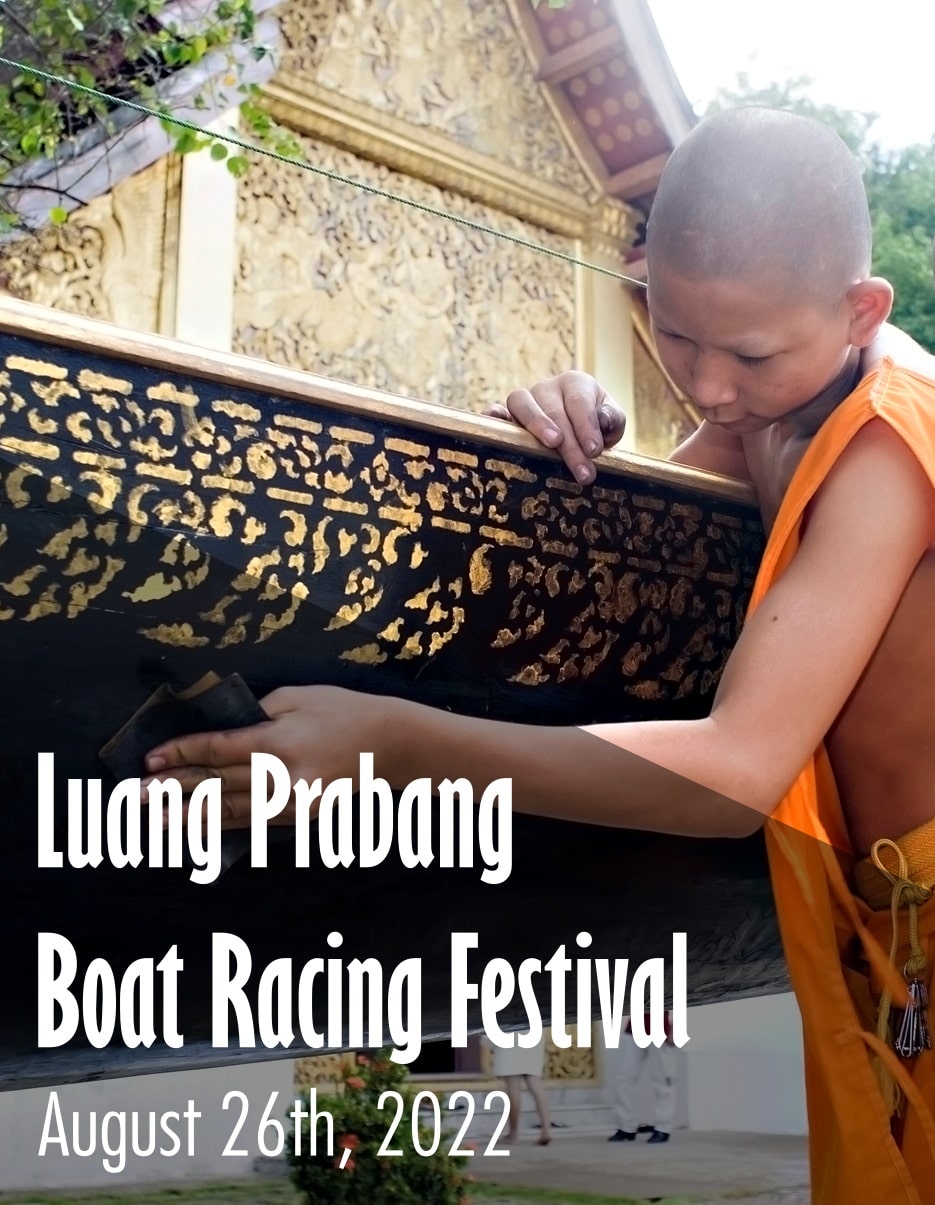Historic Downtown Savannakhet
A half-day walking tour of town winds past 19 points of interest including the home of Lao PDR’s first prime minister Kaysone Phomvihane, the 16th century Vat Xaiyaphoum, the Dinosaur Museum, Saint Theresa Catholic Church, and plenty of French colonial structures.
Start at the residence of Kaysone Phomvihane, who was born and raised in Savannakhet. Kaysone met Ho Chi Minh while studying in Hanoi. He went on to become one of the co-founders of the Lao People’s Revolutionary Party and a leader of the Pathet Lao armed forces.
Stop at Vat Xaiyaphoum, Savannakhet’s oldest Buddhist temple. Originally constructed in 1542, near the Mekong River during the reign of King Saysethatirath, today’s structures were rebuilt in 1906, but maintain their original architectural style.
Learn all about this distinct province at the Savannakhet Provincial Museum, located in a renovated colonial administrative building on the town’s south side. Inside, you’ll find a collection of the province’s natural, ethnological, historical, and revolutionary artefacts.
Don’t miss the Dinosaur Museum and its displays of Savannakhet’s pre-history including dinosaur bones, fossils and meteorite fragments. The collection was started in 1936, when French geologist Josué Heilman Hoffet discovered fossilized dinosaur bones about 120 kilometres east of town. In 1990, a joint Lao-French team rediscovered Hoffet’s site and uncovered more remains in the Ban Tangvai area.
Other must-see attractions in Downtown Savannakhet include:
- Talat Yen Plaza and its surrounding French colonial structures
- Lao Chaleun Theatre’s Art Deco façade
- Soumpholphakdy House, the Art Deco residence of a French officer
- Sala Savanh Guest House, the former Thai Consulate built in 1926
- Saint Theresa Catholic Church at Talat Yen Plaza, built in the 1920s
- The Deer House, an excellent example of a French colonial house
Savannakhet Outskirts
Tackle this one-day circuit by car or van, tuk tuk, motorbike, or bicycle, and visit That Ing Hang Stupa, Dong Natad Protected Area, Nong Lom and Bungva Lakes, the Phonsim ruins, and Phonsim Turtle Lake.
Savannakhet’s most sacred site, That Ing Hang, headlines the circuit’s attractions. Some say Indian King Asoka created a monument in 225 BC to sanctify the site where Buddha is believed to have delivered a sermon. It is also thought that the Phathat (funeral reliquary) houses parts of Buddha’s spine.
Research shows that a Mon Empire king erected a stupa there 1,500 years ago. This smaller monument and area surrounding it was enlarged by King Saysethatirath in the 16th century. In 1930, a 9-meter-tall, three-tiered stucco stupa was constructed in Lane Xang style with the upper level symbolizing a lotus.
Just east of That Ing Hang is Ban Phonsim, with a short trail to the ruins of the original Phonsim settlement. The foundations of a pagoda and the town wall sit atop a hill surrounded by bamboo forest.
A 3-km trail continues to Phonsim Turtle Lake, originally constructed to irrigate rice paddies. You can see beautiful lotus blooms, buffaloes bathing, and migratory birds, but unfortunately the turtles have vanished.
About 6 km south, stop at Bungva Lake to relax in one of the shoreline gazebos and enjoy a beautiful view of the surrounding rice fields.
Located about 2 km from That Ing Hang, the Dong Natad Protected Area presents an ancient forest of towering trees where traditional forest products such as honey and plants are collected for food and medicine. You can see locals extracting nyang oil from trees to fuel torches that light their homes.
In the centre of Dong Natad is the legendary Nong Lom Lake, which can easily be reached on a 3-km nature trail. On the way, you can observe birds, butterflies, rare plants, and traditional village life.
Further west in Ban Nateuy village, where natural salt is produced from the ground water which is saltier than seawater.
Champone Loop
This one-or-two-day circuit takes in the Hotay Pidok Library with thousands of ancient palm-leaf manuscripts, the sacred Monkey Forest with countless simians, Turtle Lake with enchanted turtles, and Soui Lake’s distinct irrigation system.
Begin your investigation of Champone at the Hotay Pidok Library, the country’s most important repository of palm leaf books written in ancient Lao, Burmese, Pali, and Khmer. Originally constructed in the late 18th century, the library houses some 4,000 books containing 361 different stories, which are kept in good condition by monks and locals.
From here, a 3-km trail leads to the Sacred Monkey Forest, with more than 3,000 of the mischief-making primates inhabiting the 3-hectare reserve. To meet the monkeys, offer them food while walking along the trail. The monkeys can also be spotted feeding at one of the forest’s many spirit houses, where locals place food to make merit. Many animals make their home at the forest’s temple, where monks care for them.
Next, travel 8 km west to Soui Lake and its stepped irrigation dam and small islands, where villagers catch fish and snails during the dry season. You can taste these and other local foods while viewing lotus blooms and migratory birds such as white storks.
Drive to Turtle Lake, where legendary resident ghosts are kept from harming the turtles by the natural lake’s spirit house. The turtles are of different sizes and ages, and local children are experts at luring them from the depths with food.
A 7-km ride north reaches the Taleo Old Temple just outside Ban Taleo Gnai. The early 20th century structure resembles a Catholic church with a Buddha statue in its alcove. Inside colourful murals recount the history of the temple and Buddha. American bombing in 1969 took its toll on many of the surrounding buildings, but the main temple remains intact.
Here is our Xe Champhone Loop travel guide
Mekong River South
Take this 1-day circuit to explore an area with a long history of diverse civilizations. Among the stops are That Phonh Stupa, Huean Hin ancient Khmer rest house, traditional Phouthai cotton-weaving villages, and Kong Phanang’s unusual rock formations.
Begin your adventure at That Phonh stupa, where Buddha is said to have passed after leaving That Ing Hang. According to legend, he took only one step to reach the sacred spot, which is more than 40 km away. It is believed That Phonh was erected between 557 and 700 AD, and then reconstructed in the 16th century.
Just before the turnoff to That Phonh, Vat Sisaket and Palm Garden present the typical palm-tree and rice-paddy landscape of the area.
Continue to the Laha group of Phouthai weaving villages, and watch them hand-spin and naturally dye cotton textiles in traditional and modern styles. This community sends its high-quality crafts to markets in nearby Pakxong and Vientiane. Some can be found in museum collections worldwide.
About 7 km away in Ban Lahakok, visit the square-shaped That Oumoung stupa, which was built between 1940 and 1950, and resembles That Ing Hang. The monument is topped with very unique ornamentation inspired by the banana flower. Further south on Route 13 sits the legendary Tham Phaseng caves.
Along the Mekong, you’ll find Heuan Hin (Stone House), which is believed to be one of 121 stone rest houses constructed by Jayavarman VII (1181-1218) along the roads that connected all corners of the Khmer empire. The Mekong riverside structure is in ruins but well worth a visit.
The Kong Phanang Panorama presents one of the Mekong’s many natural wonders. Massive rocks jut from the river to create scores of mini-islands, with more than 10 caves at nearby Tham Pulan. Some believe that centuries ago, the area’s earliest inhabitants used these huge stones as construction materials. During the dry season, a walking path leads to an excellent view of this amazing natural site.
Ho Chi Minh Trail
Explore this well-known wartime transport route on a multi-day tour. Walk branches of the legendary trail on a trek through protected forests and see ruins of the Prince Souphanouvong Bridge destroyed by war-time bombing. Venture to Vilabouly’s Stone Pillars and the new Lao-Viet Commemorative War Museum at Ban Dong in Sepon.
Inspect the remnants of the Prince Souphanouvong Bridge, the target of 1968 US air raids, in Ban Tad Hay. Named after a founder of the Lao People’s Revolutionary Party and the first president of the Lao PDR, Prince Souphanouvong designed and supervised the construction of this bridge crossing the Xe Bang Hieng River in 1942.
Located 3 km upriver, check out the rocky Sammateak Rapids, an ideal area for swimming, rafting, and kayaking. Along the riverside, craters left by aerial bombing can be seen. On the way to Tad Hay Village, about 5 km south of Phine, there is an excellent panoramic view of the area.
Visit the new Lao-Viet Commemorative War Museum and its display of battle memorabilia such as tanks, guns, bombs, and other weapons, as well as photos of soldiers and villagers. Local history experts, who have a first-hand knowledge of the fighting, were consulted on the design and content of the exhibition.
A few kilometres past the museum is the Lam Son 719 battlefield, the site of a decisive 1971 confrontation during the Indochina War, This was the only land-battle in Laos that the US Army supported by supplying tanks and other ground support to the South Vietnamese troops. Despite this support, the South Vietnamese lost the battle and recorded heavy casualties. Nearby, see the suspended cable bridge that was once part of the Ho Chi Minh Trail.
During the dry season (November-April), visitors can observe dinosaur footprints on the Xe Xang Soi riverbed at Phalanxay, about 100 km east of Savannakhet Town on Route 9.
Stop in the Phouthai Lao Silk-Cotton Weaving Centre at Ban Nong Kadaeng near Vilabouly Town in the mountainous east. Here, the descendants of the original Phouthai settlers continue to produce traditional cotton and silk hand-woven products.
About 18 km from Vilabouly, visit That Nang Lao stupa, which houses the remains of a Phouthai princess who was sent by her husband Prince Anouvong (1805-1828) to govern the local Phouthai people. Visitors to Vilabouly Town can also view a gold mine a few kilometres east of town.
Watch the Phouthai women in Ban Non Yang near Phine brew traditional rice alcohol, which is available for sale. Some make a special brew infused with herbs that is said to have the same effect as Viagra.
Meet ethnic Bru, Tri, and Katang women in remote Nong District as they weave distinctive textiles with highly complex patterns. If you don’t have time to visit the weaving villages, purchase a textile at the Craft Centre in Phine or the ODOP Centre in Savannakhet Town.
Easily accessed from Route 9 in an area that was once part of the Ho Chi Minh Trail, Tad Salene Waterfall drops 80 metres in densely forested setting. Craters caused by bombing during the war can be seen along the way, as can locals cultivating fruits and coffee.
Nearby, Ban Sepon Kao (Old Sepon) sits on the bank of the Xe Bang Hieng River on Route 9 just east of present-day Sepon Town. The old village retains an atmosphere of days gone by. From Old Sepon, trekkers can hike the 10-km trail to the Sakhoe Waterfall and from there to Salene Waterfall. Another 8-km branch of the trail leads to the Sadee Waterfall.
The towering Stone Pillars, a natural geological wonder, rise in the deep jungle, yet are easily accessed via a dirt road that was once a section of the Ho Chi Minh Trail linking Vilabouly Town to Khammouane Province. Here, you can become familiar with the Trail’s rugged terrain.
Phalong Waterfall is located 20 km south of Vilabouly in Phou Xang Hae National Protected Area (NPA) and is easily accessible from Route 28A. Trekking and homestays in the NPA are available during the dry season.



















